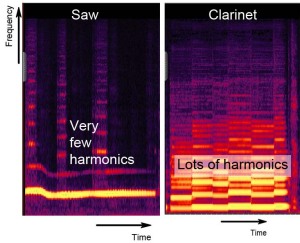In my last post on musical saw’s I wrote:
“The tone of the saw is unlike conventional instruments, it’s very clear and pure. This happens because the instrument makes very few higher harmonics to add colour to the sound.”
which prompted a comment:
“I would say that on the saw the overtones are vivid and easier to hear. I think a greater number of harmonics are present, not fewer … Perhaps this is an unscientific answer, but it is how I perceive the sound.”
The short answer to this question is given by the spot-the-difference picture below.

Read on for a more detailed explanation.It’s going to be easier to understand after listening to this sound: Musical saw {1}

The first three notes of the musical saw you heard are at about 800 Hz, which means the saw is vibrating back and forth 800 times a second. (In musical notation this is roughly an F above the tuning A). How I worked the frequency out was by looking at the graph to the right {3}. The top green graph is how sound files normally look, but the bottom graph is much more interesting and useful for analysis. It shows how the frequency content of the note varies with time. A bright line at around 800 Hz can be seen for the first three notes (it starts a bit higher then drops a little) indicating lots of energy at that frequency.
Whenever a musical instrument plays a note, it actually makes sound at many different frequencies. So as well as the fundamental sound at 800Hz, a clear line at twice that frequency (1600 Hz) can be seen. This is the first harmonic {2}. Your ear doesn’t hear these sounds as separate, but lumps them together. Harmonics alter the quality of the sound (musicians call this timbre), but the pitch is heard at the fundamental frequency of 800 Hz {5}.
Most of the time, the saw only makes sound at the fundamental frequency and its first harmonic, although three times in the plot, many more harmonics are generated as shown by additional bright horizontal lines. When the note produced by the saw is very ‘pure/clean’ then only the fundamental frequency and first harmonic are produced. When a more ‘scratchy’ sound is heard, this is when the additional harmonics appear.
Clarinet {2}

This contrasts with other musical instruments. Take for example a clarinet note. Numerous bright horizontal bands are shown, each marking the presence of a harmonic – there are lots of them.
In summary, from a science perspective, most musical instruments contain many more harmonics than the musical saw.
Sources and footnotes
{1} http://www.freesound.org/samplesViewSingle.php?id=80692, DJ Burnham, work licensed under a Creative Commons Sampling Plus 1.0 License.
{2) http://www.freesound.org/samplesViewSingle.php?id=20929 stephenchai, work licensed under a Creative Commons Sampling Plus 1.0 License.
{3} FYI: This was done in Adobe Audition.
{4} In some notation systems this would be called the second harmonic.
{5} Some notes on some musical instruments have missing fundamentals, but this isn’t the case here.
3 responses to “Musical saws and harmonics”
Hello, My name is Shinsaku Murakawa. I am leaving this message from Tokyo, Japan. I am also a musical saw player in one of my hobby.
Your data is quite interesting ! I have seriously considered to make an own home made musical saw. Once I have a stainless steel plate cut. But it did not workable. After the try, I began gathering scientific information on musical saw.
As well as the data you show, according to page 107 of http://imi.aau.dk/~sts/serafinthesis.pdf, harmonics will diminish faster than base frequency. It means, if you want to create clearer sound with you saw, time of friction should be shorter.
In this, I can not imagin how saw blade move still. At first, I thought blade move like string between the top of sigmoid curve of blade. But watching at http://m.youtube.com/#/watch?v=X7Gc_Fi4yM4&desktop_uri=%2Fwatch%3Fv%3DX7Gc_Fi4yM4&gl=JP , it seems that the blade move like drum.
If you would have further scientific data to show us, I will greatly appreciated.
Well, my play in YouTube is;
http://m.youtube.com/results?q=leon5373
Thank you and regards,
Shinsaku
From Scandinavia: Thank you for two fine articles. I have been very interested in how to see and measure harmonics. Do you know of any free software to start with harmonics – and later: The best ons which are for sale.
Here is an excellent one for you from here in Europe: You can test the software – also the advanced version – for free during one month. My choir have been singing in overtones-harmonics and we use this software for exercising our voices. It worked very well alson for tuning my grand piano:))
[…] Cox, Trevor. “Musical Saws and Harmonics.” The Sound Blog, 31 Dec. 2009, acousticengineering.wordpress.com/2009/12/31/musical-saws-and-harmonics/. […]